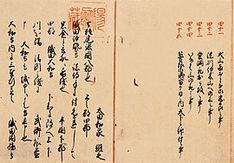 Source: Wikipedia.jp
Source: Wikipedia.jp In the meantime, given its historical importance, the Shinchō Kōki presents an interesting and fitting challenge for translation (I am, of course, aware that this work has already been translated into English by Jurguis Elisonas, or George Elison, and Jerome Lamers as ‘The Chronicle of Lord Nobunaga’. To those that doubt the usefulness of pursuing another translation, I say what the hell, I can but try).
The record itself (信長公記, also referred to as the Shinchō Ki, or 信長記) is the work of Ōta Izumi no Kami Gyūichi (大田和泉守牛一) (or ‘Ushikazu’, as there is some dispute as to the correct reading of his personal name), a retainer of Oda Nobunaga and later Toyotomi Hideyoshi. According to Sakakiyama Jun (whose modern translation of the original Shinchō Kōki is my main source - to purists I do apologise, but given that I am not Helen McCullough and that I do not make a living from pre-modern translations, some leeway will be necessary), Gyūichi was born in the village of Yasugui (or Anshoku) in Yamada Shō, Kasugai Gun, in the province of Owari in the 7th year of Daiei (1527), and was commonly known as Matasuke (又助).
Gyūichi began his service to Nobunaga (from which the Shinchō in the work’s title is derived, given that the On reading for the characters for Nobunaga are read as Shinchō, although again there is some debate about whether the title should be read as Shinchō or as Nobunaga) as a foot soldier (otherwise known as an ‘ashigaru’, or 足軽). Such was his prowess with a bow that he was soon promoted to third bow, and later formed part of Nobunaga’s personal bodyguard as the third of six ‘spears’ (a title bestowed on the most proficient soldiers appointed to protect a prominent general). In the 8th year of Eiroku (1565), Nobunaga carried out an attack against the Dōhora fort which belonged to Nagai Hayato no Kami, a retainer of Saitō Yoshitatsu (斉藤義竜) (20. These numbers refer to the page numbers in Sakakiyama Jun’s translation).
Gyūichi, acting on his own, scaled a tall building at the front of the fort and from the roof began to release a steady stream of arrows. Nobunaga believed him loyal enough that he used him another three times as a messenger, praised him as “working as if his life depended on it” and promoted him. For someone who began life as no more than a rural samurai with no family name, Gyūichi displayed remarkable tenacity and desire for knowledge. He was mostly self-taught, and came to serve as a personal attendant to Nobunaga and to Hideyoshi. He later served as an overseer (or daikan) to territory in Yamashiro and Ōmi provinces which he received directly from Hideyoshi, he was responsible for the construction of one section of the castle of Nagoya in Hizen province, and he worked in a bureaucratic role, meeting with dignitaries sent from Ming China.(21)
Gyūichi’s devotion to learning was such that it impressed those who ordinarily dedicated themselves to study. The diary of the Zen monk Saishō Shōtai, known as the Nichiyō Shū (日用集), contains an entry dated for the 22nd day of the 11th month of the 17th year of Tenshō (1589) which says the following…”In the evening I was visited by Lord Ōta Matasuke. He asked questions concerning the Mōkyū (蒙求, a Chinese historical record), and we discussed 5 or 6 historical figures”. Despite the fact that Gyūichi would have been over 60 years old by Tenshō 17, his love of learning never waned. Hence Gyūichi’s tenacity, the fact that he was personally present at many of the events described in his record, and his attention to detail have all contributed to the Shinchō Kōki’s reputation as a reliable historical resource.(21)
As for the Shinchō Kōki itself, it was completed by Gyūichi in the 15th year of Keichō (1610) in the early Edo period, and is the first historical record that concerns the life of Oda Nobunaga. Overall it consists of 16 scrolls, which are divided into 8 scrolls each. The first eight describe the early period of Nobunaga’s life, from his birth through to his arrival in Kyoto together with the Shōgun Ashikaga Yoshiaki in Eiroku 11 (1568), while the latter eight detail events leading up to Nobunaga’s dramatic death at Honnōji temple in Tenshō 10 (1582). The record covers all of the major events in Nobunaga’s life, and has been the principal source for historians regarding those events, including the battles of Okehazama, Anegawa, the suppression of the Ikkō Ikki in Ise and Echizen provinces, the burning of Enryakuji, and the war against Ishiyama Honganji.
Given that it was written by a close retainer of Oda Nobunaga, it is obviously heavily influenced by opinions drawn from among members of the Oda and Toyotomi households. There are also some theories that the work was not that solely of Gyūichi, and that he may have received some assistance (given that Nobunaga is variously referred to as 上様 (Uesama, literally ‘lord’), 信長公 (Nobunaga-Oyake), and 信長(Nobunaga). Nevertheless, the record gives a fascinating insight into sixteenth century Japan and the character of Nobunaga and his retainers. The translation itself will probably need to be transferred to my web site at some point (given the sheer volume of material and the need to organise it all in one, easy to access format), but for the time being it shall make up quite a few posts on this blog.
 RSS Feed
RSS Feed